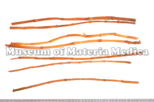Imperata Rhizome

|
TMPW No.:440 |
| Synonym | |
| Latin name | Imperatae Rhizoma |
| Botanical source: Family name | Graminae |
| Botanical source: Plant name | Imperata cylindrica P.Beauvois (IPNI:30138371-2) |
| Part used | Rhizome |
| Empirical criteria for quality selection | Good one is thicker, longer and light-colored (yellowish-white in color). (TN) |
| Constituents | Other aliphatic and related compounds: Citric acid, Malic acid Monosaccharides: D-Fructose, D-Glucose, D-Xylose Oligosaccharides: Sucrose Triterpenoids: Simiarenol, Cylindrin, Arundoin, Fernenol, Isoarborinol Other: Potassium salt |
| Pharmacological effects | Diuresis (water extract). |
| Indications | As an antiinflammatory diuretic, antifebrile, blood cleanser and hemostatic, it is applied to treat heat disease, hematemesis, epistaxis, hematuria, edema, jaundice, oliguria, thirst, asthma and nausea. |
| Diseases | Hematemesis, Nasal hemorrhage, Hematuria, Thirst, Vomitting, Nausea, Hiccup, Measles, High fever, Cough, Jaundice, Acute nephritis, Urodynia, Dysuria |
| Formulas | |
| Meridian tropism | Lung, Stomach |
| Property | Cold |
| Flavor | Sweet |
| Classification in "Shen-non Ben-cao Jing" | Middle |
| TCM: Classification | Hemostatics |
| TCM: Medicinal effects | To arrest bleeding by reducing heat in blood, to remove heat, and to cause diuresis. For hematemesis, epistaxis, and hematuria due to heat in the blood, febrile disease with thirst, jaundice, urinary infection due to difficult painful urination, and edema in acute nephritis. |
| Remarks | Listed in the Japanese Pharmacopoeia 18th ed. |
| References | TN: T. Namba & Y. Tsuda ed., Outline of Pharmacognosy, a Textbook, 3rd ed., Nankodo Co., Ltd., Tokyo, 1998. |
